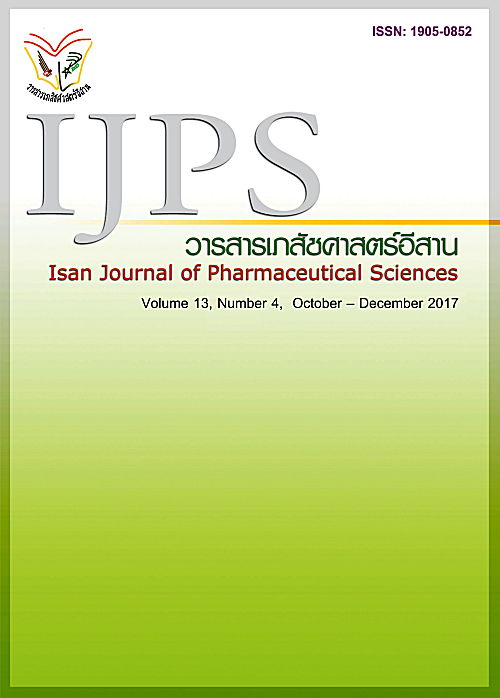Prescribing Pattern of Antifungal Agents for Superficial Fungal Infection at a District Hospital
Main Article Content
Abstract
Ketoconazole is well known antifungal drug associated with potential risk of liver injury. Due to this side effect, oral ketoconazole has been withdrawn from the markets in several countries. This study aims to describe pattern of oral antifungal drug prescriptions including ketoconazole, itraconazole, fluconazole and griseofulvin for treatment of superficial fungal infections and pattern of liver function monitoring at a District Hospital. These four drugs are listed in hospital formulary of the study hospital. Methods: Outpatient medical records of the year 2011 to 2015 were reviewed. The study included patients 15 year of age or older who received the study antifungal drugs for treatment of superficial fungal infections. In case of patients who had more than one time of treatment since the first date of study period, only the first treatment course was considered. Patients who had history of tuberculosis and patients whose interested variables were not available were excluded. Study variables included gender, age, payment scheme, history of alcohol drinking, history of liver disease, underlying diseases, previous use of oral antifungal drugs, treatment indication, dose in unit of defined daily dose (DDD), duration, drug-drug interactions, liver function monitoring and abnormality. Descriptive statistics were used to describe characteristics of study samples, prescribing pattern, and liver function monitoring. Results: Of all 227 studied patients, their average age was 51.6 years. The most common prescribed drugs were griseofulvin (44.1%) and ketoconazole (40.1%). Ketoconazole was commonly prescribed for treatment of tinea cruris/corporis (n= 23) and onychomycosis (n= 22). Griseofulvin was major prescribed for treatment of onychomycosis (n= 56). Treatment indication with highest volume and longest duration of use of ketoconazole (42 DDD, 28.5 days) and griseofulvin (141 DDD, 143.5 days) was onychomycosis. Proportions of patients who were monitored for liver function within one week before treatment, during treatment, and within 3 months after drug discontinuation were 5.7%, 9.3%, and 7.1%, respectively. Conclusion: Ketoconazole and griseofulvin were the most common antifungal drugs used for superficial fungal infection. Treatment indication which was potential to expose high volume of drugs and long term used was onychomycosis. Liver function monitoring was rarely performed. Due to potential risk of hepatotoxicity, clinical guideline for prescribing ketoconazole should be revised.
Article Details
In the case that some parts are used by others The author must Confirm that obtaining permission to use some of the original authors. And must attach evidence That the permission has been included
References
Ameen M, Lear JT, Madan V, Mohd Mustapa MF, Richardson M. British association of dermatologists’ guidelines for the management of onychomycosis 2014. Br J Dermatol. 2014; 171(5):937–58.
Dias MFRG, Bernardes-Filho F, Quaresma-Santos MVP, Amorim AG da F, Schechtman RC, Azulay DR. Treatment of superficial mycoses: review. Part II. An Bras Dermatol. 2013; 88 (6):937–44.
Dias MFRG, Quaresma-Santos MVP, Bernardes-Filho F, Amorim AGDF, Schechtman RC, Azulay DR. Update on therapy for superficial mycoses: review article part I. An Bras Dermatol. 2013; 88 (5):764–74.
European Medicines Agency. European Medicines Agency recommends suspension of marketing authorisations for oral ketoconazole [Online]. 2013 July 26. [cited 2015 Sep 30]. Available from: https://www.ema.europa.eu/ema/index.jsp?curl=pages/news_and_events/news/2013/07/news_detail_001855.jsp&mid=WC0b01ac058004d5c1
Gupta AK, Lyons DC. The rise and fall of oral ketoconazole. J Cutan Med Surg. 2015; 19(4): 352–7.
Health Canada. Health Canada endorsed important safety information on ketoconazole [Online]. 2013 June 19. [cited 2015 Sep 30]. Available from: https://healthycanadians.gc.ca/recall-alert-rappel-avis/hc-sc/2013/34173a-eng.php
Health Product Vigilance Center, Food and Drug Administration of Thailand. Ketoconazole and risk of hepatotoxicity. Health Product Vigilance Center Newsletter. September 12, 2011.
Kao WY, Su CW, Huang YS, Chou YC, Chen YC, Chung WH, et al. Risk of oral antifungal agent-induced liver injury in Taiwanese. Br J Clin Pharmacol. 2014; 77(1): 180–9.
Mandel GL, Bennett JE, Dolin R, eds. Mandell, Douglas and Bennett’s Principles and Practice of Infectious Diseases. 6th ed. New York, NY: Churchill Livingstone; 2005.
McNaughton R, Huet G, Shakir S. An investigation into drug products withdrawn from the EU market between 2002 and 2011 for safety reasons and the evidence used to support the decision-making. BMJ Open. 2014; 4(1) :e004221.
National Drug Development Board. National list of Essential Medicines, 2016 [Online]. 2016 February 19. [cited 2016 Sep 9]. Available from https://drug.fda.moph.go.th:81/nlem.in.th/
Raschi E, Poluzzi E, Koci A, Caraceni P, Ponti F De. Assessing liver injury associated with antimycotics: Concise literature review and clues from data mining of the FAERS database. World J Hepatol. 2014; 6(8): 601–12.
Sahoo AK, Mahajan R. Management of tinea corporis, tinea cruris, and tinea pedis: A comprehensive review. Indian Dermatol Online J. 2016; 7(2):77–86.
Sindhuphak W, Niumpradit N, Ungpakorn R. Clinical practice guideline superficial fungal infection. Thai J Dermatol 2011; 112-29.
Sutepvarnon A, Apisarnthanarak A, Camins B, Mondy K, Fraser VJ. Inappropriate use of antifungal medications in a tertiary care center in Thailand: a prospective study. Infect Control Hosp Epidemiol 2008; 29 (4): 370-3
Tatro DS. Drug Interaction Facts: The authority on drug interaction 2015. United States. Facts & Comparisons Publishing Group.
U.S. Food and Drug Administration. FDA Drug Safety Communication: FDA limits usage of Nizoral (ketoconazole ) oral tablets due to potentially fatal liver injury and risk of drug interactions and adrenal gland problems [Online]. 2013 July 26. [cited 2015 Sep 30]. Available from: https://www.fda.gov/downloads/Drugs/DrugSafety/UCM362444.pdf
Yan JY, Nie XL, Tao QM, Zhan SY, Zhang Y De. Ketoconazole associated hepatotoxicity: a systematic review and meta- analysis. Biomed Environ Sci. 2013; 26(7): 605–10.
World Health Organization for Drug Statistics Methodology. ATC/DDD Index 2017 [Online]. [cited 2017 Jan 30]. Available from: https://www.whocc.no/atc_ddd_index/


